French curtains. DIY design and tailoring of French curtains
Curtains are the main element of the interior. They perform not only a decorating function, but also a protective one, hiding the room from prying eyes and preventing the penetration of bright sunlight. However, in order for the window drapery to look decent, it is necessary to choose the right product design.
Lovers of lightness and airiness most often choose French curtains. Such models are quite voluminous, which gives the room a certain theme. The originality of the design will create a cozy and comfortable space.
Any housewife can sew such curtains on her own. All handmade items have a special meaning. To help everyone who wants to try their hand at needlework, we will provide detailed information below, where a master class of French curtains will be presented.
What is the design feature?
The traditional design of French curtains came to modern interiors from the distant 14th century. At that time, they were at the peak of popularity and were used to decorate palaces and royal chambers. Of course, only wealthy people could afford such a luxury. However, at present, such drapery has somewhat lost its position to other options. Nevertheless, it still remains quite popular.
French curtains, made by hand, will decorate any room: living room, study, kitchen, bedroom. They will transform the interior, giving it smoothness and softness of lines. This opportunity appears due to a certain style. Its main elements are festoons. It is they who form beautiful lush folds, the distance between them and the number can vary significantly. Their shape is arched, freely hanging.
The width and height of the curtains are determined by the size of the window opening, but you need to remember that they do not move apart. Some models are made with a lifting mechanism (manual or electric).
A bit of France in the interior
People who want to create a majestic and stylish interior are advised to opt for the classics. It includes all the necessary elements. Such a space is truly royal, and if it is supplemented with scalloped curtains, then in addition to pomp, romanticism characteristic of the French will appear. To this day, this design is in great demand, and, oddly enough, the design is original.
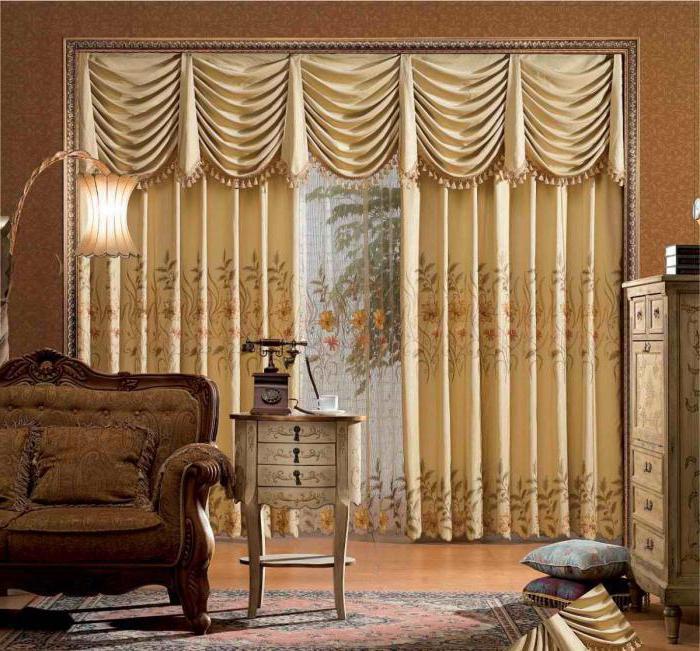
French curtains for the kitchen, office, living room will look as harmonious as possible if the window openings in the room are large enough. In order to independently create such a style, correctly conveying all the details, you need to familiarize yourself with the key points:
- The length of the curtain can be up to the floor or up to the windowsill.
- The material is selected light and transparent to give airiness to the product.
- The curtain is sewn only from a single piece of fabric.
- Sections with folds should be at least four.
Advantages
- Scallops arranged vertically visually increase the height of the room.
- The appearance of the curtains does not require additional drapery, however, if necessary, you can use thick curtains and lambrequins.
- The original design of the product can decorate any interior.
- If you sew French curtains with your own hands, it will turn out quite inexpensively.
- The installed lifting mechanism makes it easy to raise or lower the window drapery.
- Freely falling folds will save the hostess from time-consuming ironing.
Fulfillment of desires
So, it was decided to sew curtains on their own. Where to start this process? First of all, you need to choose the right material. It must meet the following requirements:
- naturalness;
- ease;
- transparency.
It is not recommended to sew French curtains from heavy fabrics, as the finished product will look quite rough and too catchy, which will only spoil the overall impression of the room.
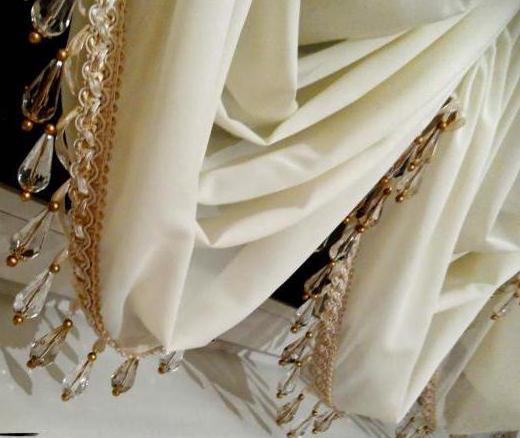
Optimal options:
- tulle;
- atlas;
- silk;
- batiste.
Color spectrum
In order for everything to harmonize in the interior, it is necessary to carefully select the palette. One of the determining factors is the purpose and style of the room. You should also pay attention to the location of the windows. However, even regardless of this, it is highly recommended not to use too bright artificial shades, as they will break the idyll. 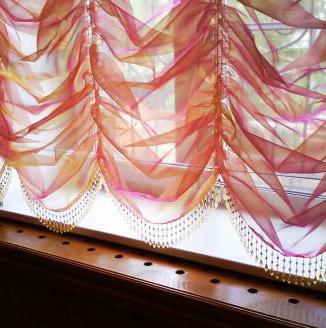
French curtains are most harmonious in pastel colors:
- tender peach;
- calm beige;
- white - a classic of the genre;
- sky blue;
- glam pink.
In any case, the choice of colors is completely individual, depending on personal preferences, but you should still take into account the recommendations of qualified designers.
Fabric consumption
Before embarking on independent sewing of French curtains, it is necessary to study the subtlety of the calculation of the material. As a rule, the length of the cornice is taken as the main parameter, and the allowance for folds is also taken into account. Do not forget about the seams, their width is from 1 to 2 cm, so 4-6 cm must be added to the existing sizes.
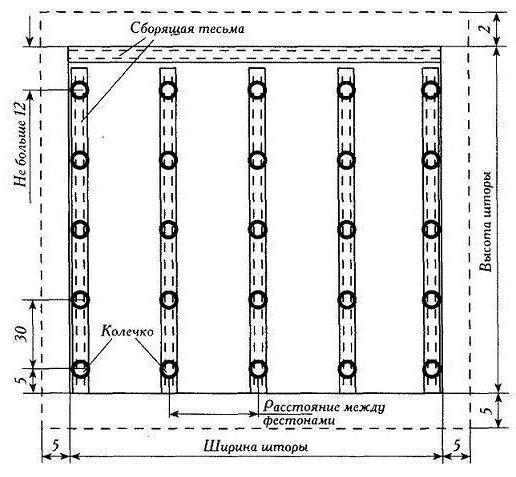
The French Curtain pattern shows the exact size between the rings through which the tie cords will be pulled. From this we can conclude that the final length of the product will be significantly reduced. In order to choose the ideal parameter, you will need to measure the desired size and increase this figure by 1.5-2.5 times (the coefficient varies depending on the depth of the folds). Be sure to add 5 cm above and below this length.
Calculation example:
- curtain width: the average length of the cornice is 150-250 cm, multiplied by a factor of 1.5-2 for light folds, by 2.5 for deep scallops;
- curtain height: the length of the wall from the ceiling to the floor or window sill increases by 1.5-2-2.5 times.
How to sew French curtains: a step-by-step description
Having decided on the material, color, having calculated the width and length, you can proceed directly to sewing. It is very important to choose a convenient place where you can freely expand the canvas.
Description of works:
- The fabric is unfolded, the evenness of the cut line on all sides is checked. If there are defects, then it is necessary to correct them with scissors.
- Seam processing. The side edges are tucked up by 1-2 cm, then they are basted and ironed. After that, after checking the quality of work, you can sew with a machine seam.
- The bottom edge is processed in a similar way, however, the size of the hem in the final result should be no more than 0.5 cm.
- On the canvas, make markings according to the pattern (see above) in order to determine the place for sewing the braid with rings. The distance between it should be equal over the entire length of the curtain. After that, baste the braid, checking if it has moved during this process, and, making sure that the work is of high quality, finally sew on the sewing machine. At the same time, the ends of the braid are tucked inward so that the wrong parts of the edging and the curtains match.
- A drawstring is threaded through the rings on the braid, fastens the curtains from below and stretches. The top edge is not processed if a lifting mechanism is to be installed.
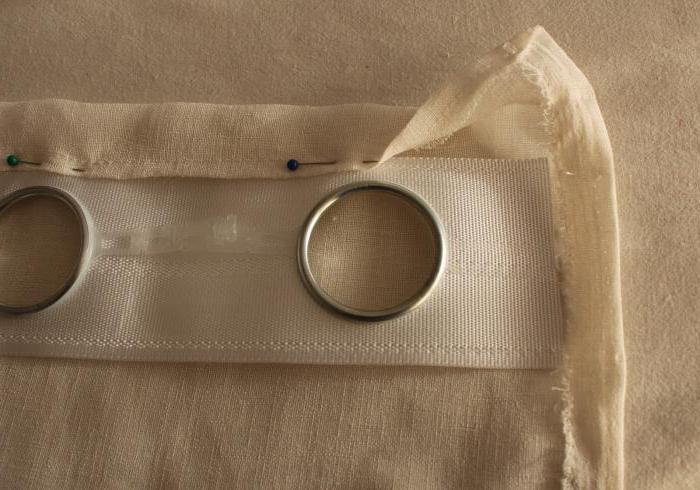
Finishing touches
The last step in sewing is the processing of the top edge. As a rule, French curtains are attached to a special bar, which is subsequently installed on the eaves. Thanks to this device, the canvas can be aligned directly on the window opening, adjusting it to the exact dimensions. However, before attaching to the bar, it is necessary to process the upper edge. To do this, first make a fabric bend 1 cm wide more than the fastening tape. It is advisable to iron so that the material retains its shape. After the tape is sewn on the wrong side. That's all, the French curtain is ready.
